Excerpts from Jim Conrad's
Naturalist Newsletter
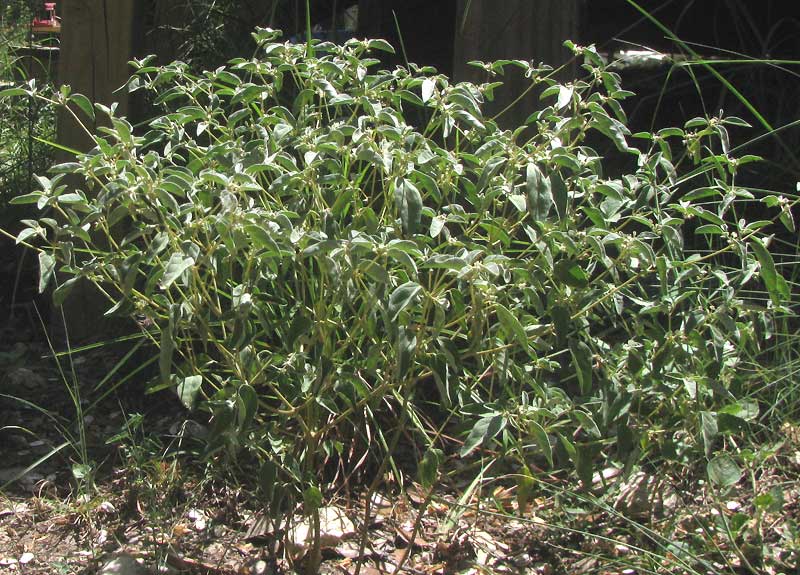
from the August 11, 2013 Newsletter issued from the Frio Canyon Nature Education Center in the valley of the Dry Frio River in northern Uvalde County, southwestern Texas, on the southern border of the Edwards Plateau; elevation ~1750m (~5750 ft); N29.62°, W99.86°; USA
PRAIRIE TEA
In the much-disturbed, tramped-on, thin, gravelly soil atop limestone bedrock within just a few feet of Juniper House here at the Center, the most common wildflower definitely is the leg-calf-high one appearing above.
Note that this herb's 5/8ths-inch-long (15mm) leaves array themselves like leaves on a tree, the tree branching and rebranching from slender trunks, like a miniature shadetree. Up closer you see more peculiarities, such as the green, immature, egg-shaped fruits shown below:
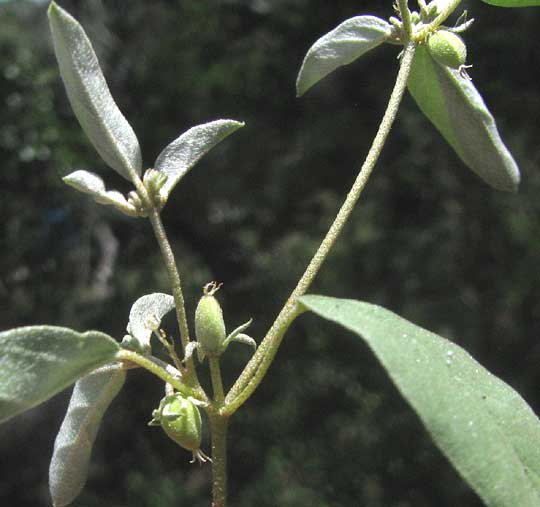
With this kind of plant it's important to notice features of the ovary, so a closer look at an immature fruit tipped with four style arms is shown below:
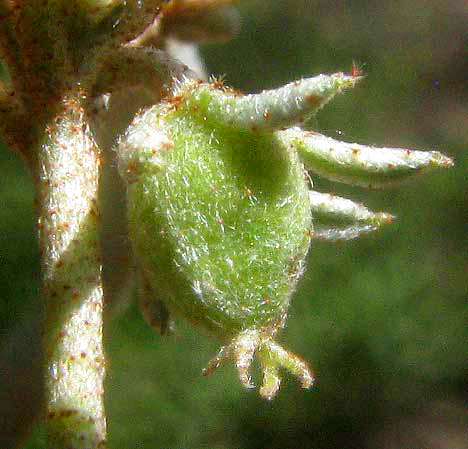
An immature fruit such as the picture shows is by definition a flower's maturing ovary. In the picture, though the flower's ovary and style arms -- female parts -- are obvious, no male stamens are to be seen. That's because we're seeing a female flower. Flowers in this species are unisexual and typically occur together in the same flower cluster. A male flower displaying four white petals and six or seven stamens is shown below:
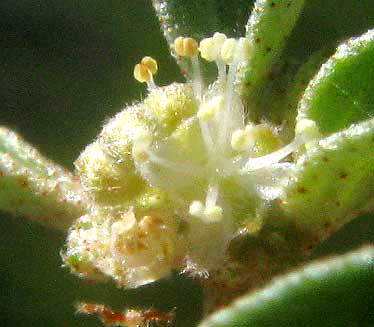
In that close-up you also see that the hairs seem to be doing something unusual. Below, you can see a leaf's hairs as they appear beneath the dissecting slope:
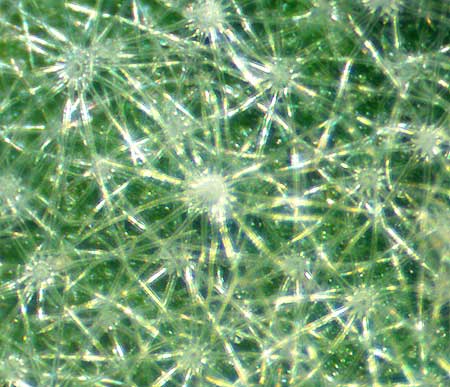
The hairs are "stellate," or starlike, with numerous slender, sharp-pointed spines radiating from a central point. Several plant families produce stellate hairs, but I've ever seen stellate hairs with more spines or growing closer together than these.
This is such a distinctive, unusual kind of plant that you recognize the group to which it belongs just by looking at it -- not by slogging through lots of obscure details. It's a member of the genus Croton, of the big Euphorbia or Spurge Family, the Euphorbiaceae. However, there are lots of crotons, with about ten species possibly occurring in our region, and at least three species already listed for Uvalde County. Therefore, even if at first glance you recognize that this is a croton, you end up "doing the botany" to figure out the species.
Our Juniper House species is CROTON MONANTHOGYNUS, distinguished from the other species by these fieldmarks: It's an herb instead of a woody bush; it's ovaries are topped with only two styles divided to their bases so that it looks like there are four styles (most other species have more style branches), and; the male flowers bear only six or so stamens (less than most other species). This is one of the most commonly occurring crotons in North America, found throughout most of the south-central and southeastern states, though curiously absent from most eastern coastal states.
Croton monanthogynus is commonly called Prairie Tea or sometimes One-seed Croton. On the Internet at least one page claims that tea can be brewed from the leaves, and that the leaves can serve as a general spice, even "as a basil substitute in your pesto." It's true that when you brush against the plant an intense, spicy, refreshing fragrance clouds all around you, but I find the leaves' taste too strong to use for anything. Also I worry about their toxicity, since many plants in the Euphorbia Family are dangerous, such as the beans from Castor plants. I've noticed that in overgrazed pastures cattle avoid eating Prairie Tea, even when it's the main species left standing.
In fact, I first noticed Prairie Tea when I was installing insulation beneath Juniper House. Upon crawling from under the building I'd find my naked, sweaty skin burning wherever I'd touched Prairie Tea, and my neighbor Phred reported the same sensation, though cool, dry skin doesn't seem to suffer. Whatever the case, I'm not brewing tea from Prairie Tea.
I'm glad to have the plant around Juniper House, however, especially because fruits of croton species are famed for their large, oily seeds that are much eaten by birds. In some places crotons have been called Dove Weeds because doves favor the seeds so.